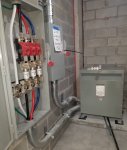Just a thought or question if you will. I dont have experience with 3ph but don't they have switches that (top feed or bottom feed) depending on need like I get for residential? That would avoid either having live fuse (no disco) or a Sw that is "off" in up position, (flipping panel over, *** not suggesting it be done***)
I definitely wouldn't want to be the one to change those fuses in that disco. Depending on voltages couldn't that pose a HUGE Arc hazard?
If it was wired the normal way (top to bottom), no. The whole bottom of the switch is dead. The switch itself is covered. The only thing exposed is the lugs at the top and even those are guarded by design and about a foot away from the fuse jacks. 480 v restricted approach boundary is 1 foot, and fuses will fall to the bottom away from live gear.
In industrial systems MOST panels are this way. When you open the disconnect or breaker, the top is still hot but it is guarded thus not a shock or arc flash hazard unless you go poking around past the guard. The other shock hazard is that quite often aux contacts wired to an external source (dry contacts) are also energized with control power, 120 VAC.
In switchgear, pulling MCC buckets, and over 1,000 VAC there will be a shutter mechanism. Over 1000 AC controls are in an isolated compartment, and the door interlock is generally not defeatable without taking it completely apart.
Arc flash is really only a hazard in two situations. The first is working on equipment that is suspect/defective. The second is when doing a task where the safety of the task is 100% relying on the person(s) doing the job. For instance racking buckets back onto energized bus especially MCC but it’s design specific, attempting to fish cable blindly into energized spaces, working above or on exposed energized equipment with tools that can short it if they fall into it, or attempting to remove or land cable while energized. All of these often end badly.
So the only people that can’t safely work on it are untrained safety inspectors that were transferred to the position because they were too dangerous to be allowed in the field.



